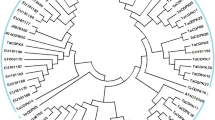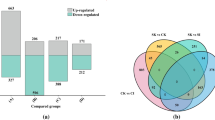Abstract
Crop productivity and yield are adversely affected by abiotic and biotic stresses. Therefore, finding out the genes responsible for stress tolerance is a significant stride towards crop improvement. A gene co-expression network is a powerful tool to detect the most connected genes during heavy metal (HM) stress in plants. The most connected genes may be responsible for HM tolerance by altering the different metabolic pathways during the biotic and abiotic stress. In the same line we have performed the GSE86807 microarray analysis of chickpea during exposure to chromium, cadmium and arsenic and analyzed the data. Common differentially expressed genes (DEGs) during exposure to chromium, cadmium and arsenic were identified and a co-expression network study was carried out. Hub and bottleneck genes were explored on the basis of degree and betweenness centrality, respectively. A gene set enrichment analysis study revealed that genes like haloacid dehydrogenase, cinnamoyl CoA reductase, F-box protein, GDSL esterase lipase, cellulose synthase, β-glucosidase 13 and isoflavone hydroxylase are significantly enriched and regulate the different pathways like riboflavin metabolism, phenyl propanoid biosynthesis, amino acid biosynthesis, isoflavonoid biosynthesis and indole alkaloid biosynthesis.



Similar content being viewed by others
References
Amrine KCH, Blanco-Ulate B and Cantu D 2015 Discovery of core biotic stress responsive genes in arabidopsis by weighted gene co-expression network analysis. PLoS One 10 e0118731
Atkinson NJ, Lilley CJ and Urwin PE 2013 Identification of genes involved in the response of Arabidopsis to simultaneous biotic and abiotic stresses. Plant Physiol. 162 2028–2041
Barceló J and Poschenrieder C 1990 Plant water relations as affected by heavy metal stress: a review. J. Plant Nutr. 13 1–37
Chatterjee S, Sau GB and Mukherjee SK 2009 Plant growth promotion by a hexavalent chromium reducing bacterial strain, Cellulosimicrobium cellulans KUCr3. World J. Microbiol. Biotechnol. 25 1829–1836
Chin CH, Chen SH, Wu HH, Ho CW, Ko MT, Lin CY 2014 Cytohubba: identifying hub objects and sub-networks from complex interactome. BMC Syst. Biol. 8 S11
Choudhary A, Pandey P and Senthil-Kumar M 2016 Tailored responses to simultaneous drought stress and pathogen infection in plants; in Drought stress tolerance in plants (eds) Hossain MA, Wani SH, Bhattacharjee S, Burritt DJ and Tran L-SP (Switzerland: Springer), Vol 1, pp. 427–438
Clijsters H and Van Assche F 1985 Inhibition of photosynthesis by heavy metals. Photosynth. Res. 7 31–40
DalCorso G, Manara A and Furini A 2013 An overview of heavy metal challenge in plants: from roots to shoots. Metallomics 5 1117
Das P, Samantaray S and Rout G 1997 Studies on cadmium toxicity in plants: a review. Environ. Pollut. 98 29–36
de Abreu Neto JB and Frei M 2016 Microarray meta-analysis focused on the response of genes involved in redox homeostasis to diverse abiotic stresses in rice. Front. Plant Sci. 6 1260
Dhal B, Thatoi H, Das N and Pandey BD 2010 Reduction of hexavalent chromium by Bacillus sp. isolated from chromite mine soils and characterization of reduced product. J. Chem. Technol. Biotechnol. 85 1471–1479
Dixon RA and Paiva NL 1995 Stress-induced phenylpropanoid metabolism. Plant Cell 7 1085
Dong H and Beer SV 2000 Riboflavin induces disease resistance in plants by activating a novel signal transduction pathway. Phytopathology 90 801–811
Fang J, Lin A, Qiu W, et al. 2016 Transcriptome profiling revealed stress-induced and disease resistance genes up-regulated in PRSV resistant transgenic papaya. Front. Plant Sci. 7 855
Flora SJS, Bhadauria S, Kannan GM and Singh N 2007 Arsenic induced oxidative stress and the role of antioxidant supplementation during chelation: a review. J. Environ. Biol. 28 333–347
Groppa MD and Benavides MP 2008 Polyamines and abiotic stress: recent advances. Amino Acids 34 35–45
Gupta K, Dey A and Gupta B 2013 Plant polyamines in abiotic stress responses. Acta Physiol. Plant. 35 2015–2036
He H, Zhan J, He L and Gu M 2012 Nitric oxide signaling in aluminum stress in plants. Protoplasma 249 483–492
Howe E, Holton K, Nair S, et al. 2010 MeV: MultiExperiment viewer; in Biomedical informatics for cancer research (eds) Ochs MF, Casagrande JT, Davuluri RV (US: Springer) pp. 267–277
Israr M, Sahi S, Datta R and Sarkar D 2006 Bioaccumulation and physiological effects of mercury in Sesbania drummondii. Chemosphere 65 591–598
Jia J, Zhou J, Shi W, et al. 2017 Comparative transcriptomic analysis reveals the roles of overlapping heat-/drought-responsive genes in poplars exposed to high temperature and drought. Sci. Rep. 7 43215
Kanehisa M, Sato Y, Kawashima M, et al. 2016 KEGG as a reference resource for gene and protein annotation. Nucleic Acids Res. 44 D457–D462
Kanehisa M, Furumichi M, Tanabe M, et al. 2017 KEGG: new perspectives on genomes, pathways, diseases and drugs. Nucleic Acids Res. 45 D353–D361
Keunen E, Remans T, Bohler S, et al. 2011 Metal-induced oxidative stress and plant mitochondria. Int. J. Mol. Sci. 12 6894–6918
Krämer U 2005 Phytoremediation: novel approaches to cleaning up polluted soils. Curr. Opin. Biotechnol. 16 133–141
Liang Y-H, Cai B, Chen F, et al. 2014 Construction and validation of a gene co-expression network in grapevine (Vitis vinifera. L.). Hortic. Res. 1 14040
Maere S, Heymans K and Kuiper M 2005 BiNGO: a cytoscape plugin to assess overrepresentation of gene ontology categories in biological networks. Bioinformatics. 21 3448–3449
Mao L, Van Hemert JL, Dash S and Dickerson JA 2009 Arabidopsis gene co-expression network and its functional modules. BMC Bioinf. 10 346
Meharg AA 2004 Arsenic in rice – understanding a new disaster for South-East Asia. Trends Plant Sci. 9 415–417
Meharg AA and Hartley-Whitaker J 2002 Arsenic uptake and metabolism in arsenic resistant and nonresistant plant species. New Phytol. 154 29–43
Mittler R 2006 Abiotic stress, the field environment and stress combination. Trends Plant Sci. 11 15–19
Nagajyoti PC, Lee KD and Sreekanth TVM 2010 Heavy metals, occurrence and toxicity for plants: a review. Environ. Chem. Lett. 8 199–216
Ogata H, Goto S, Sato K, et al. 1999 KEGG: Kyoto encyclopedia of genes and genomes. Nucleic Acids Res. 27 29–34
Oliveros JC 2007 VENNY. An interactive tool for comparing lists with Venn Diagrams. BioinfoGP of CNB-CSIC. http://bioinfogp.cnnb.csic.es/tools/venny/index.ht. Accessed 22 Mar 2018
Pandey P, Ramegowda V and Senthil-Kumar M 2015 Shared and unique responses of plants to multiple individual stresses and stress combinations: physiological and molecular mechanisms. Front. Plant Sci. https://doi.org/10.3389/fpls.2015.00723
Prasch CM and Sonnewald U 2013 Simultaneous application of heat, drought, and virus to arabidopsis plants reveals significant shifts in signaling networks. Plant Physiol. 162 1849–1866
Puckette MC, Weng H and Mahalingam R 2007 Physiological and biochemical responses to acute ozone-induced oxidative stress in Medicago truncatula. Plant Physiol. Biochem. 45 70–79
Ramu VS, Paramanantham A, Ramegowda V, et al. 2016 Transcriptome analysis of sunflower genotypes with contrasting oxidative stress tolerance reveals individual-and combined-biotic and abiotic stress tolerance mechanisms. PLoS One. https://doi.org/10.1371/journal.pone.0157522
Rao X, Huang X, Zhou Z and Lin X 2013 An improvement of the 2ˆ(-delta delta CT) method for quantitative real-time polymerase chain reaction data analysis. Biostat. Bioinform. Biomath. 3 71–85
Robinson MD, McCarthy DJ and Smyth GK 2010 Edger: a bioconductor package for differential expression analysis of digital gene expression data. Bioinformatics. 26 139–140
Salt DE, Prince RC, Pickering IJ and Raskin I 1995 Mechanisms of cadmium mobility and accumulation in Indian mustard. Plant Physiol. 109 1427–1433
Shannon P, Markiel A, Owen O II, et al. 2003 Cytoscape: a software environment for integrated models of biomolecular interaction networks. Genome Res. https://doi.org/10.1101/gr.1239303.metabolite
Sharma SS and Dietz KJ 2009 The relationship between metal toxicity and cellular redox imbalance. Trends Plant Sci. 14 43–50
Silva S 2012 Aluminium toxicity targets in plants. J. Bot. 2012 1–8
Singh VP, Srivastava PK and Prasad SM 2013 Nitric oxide alleviates arsenic-induced toxic effects in ridged Luffa seedlings. Plant Physiol. Biochem. 71 155–163
Stoeva N and Bineva T 2003 Oxidative changes and photosynthesis in oat plants grown in as-contaminated soil. Bulg. J. Plant Physiol. 29 87–95
Suzuki N, Rivero RM, Shulaev V, et al. 2014 Abiotic and biotic stress combinations. New Phytol. 203 32–43
Wang T, McFarlane HE and Persson S 2016 The impact of abiotic factors on cellulose synthesis. J. Exp. Bot. 67 543–552
Warne MSJ, Heemsbergen D, Stevens D, et al. 2008 Modeling the toxicity of copper and zinc salts to wheat in 14 soils. Environ. Toxicol. Chem. 27 786–792
Yadav SK 2010 Heavy metals toxicity in plants: an overview on the role of glutathione and phytochelatins in heavy metal stress tolerance of plants. S. Afr. J. Bot. 76 167–179
Yadav BS and Mani A 2019 Analysis of bHLH coding genes of Cicer arietinum during heavy metal stress using biological network. Physiol. Mol. Biol. Plants 25 113–121
Yadav BS, Singh S, Srivastava S and Nand Kumar Singh AM 2019 Whole transcriptome expression profiling and biological network analysis of chickpea during heavy metal stress. J. Plant Biochem. Biotechnol. https://doi.org/10.1007/s13562-019-00486-3
Ye J, Coulouris G, Zaretskaya I, et al. 2012 Primer-BLAST: a tool to design target-specific primers for polymerase chain reaction. BMC Bioinf. 13 134
Zaidi A, Wani PA and Khan MS 2012 Toxicity of heavy metals to legumes and bioremediation. Springer-Verlag, Wien. https://eurekamag.com/research/038/903/038903771.php
Zhang G, Li Q, Wang W, et al. 2018 Wheat F-box protein gene TaFBA1 is involved in plant tolerance to heat stress. Front. Plant Sci. https://doi.org/10.3389/fpls.2018.00521
Zheng K, Ni Z, Qu Y, et al. 2018 Genome-wide identification and expression analyses of TCP transcription factor genes in Gossypium barbadense. Sci. Rep. https://doi.org/10.1038/s41598-018-32626-5
Zhu W, Yang B, Komatsu S, et al. 2015 Binary stress induces an increase in indole alkaloid biosynthesis in Catharanthus roseus. Front Plant Sci. 6 1–12
Acknowledgements
BSY is thankful to the DST INSPIRE program for a fellowship. AM is thankful to MNNIT Allahabad for a TEQIPII grant.
Author information
Authors and Affiliations
Corresponding author
Additional information
Communicated by Manchikatla Venkat Rajam.
Corresponding editor: Manchikatla Venkat Rajam
Electronic supplementary material
Below is the link to the electronic supplementary material.
Rights and permissions
About this article
Cite this article
Yadav, B.S., Singh, S., Srivastava, S. et al. Analysis of chickpea gene co-expression networks and pathways during heavy metal stress. J Biosci 44, 99 (2019). https://doi.org/10.1007/s12038-019-9899-x
Received:
Accepted:
Published:
DOI: https://doi.org/10.1007/s12038-019-9899-x




